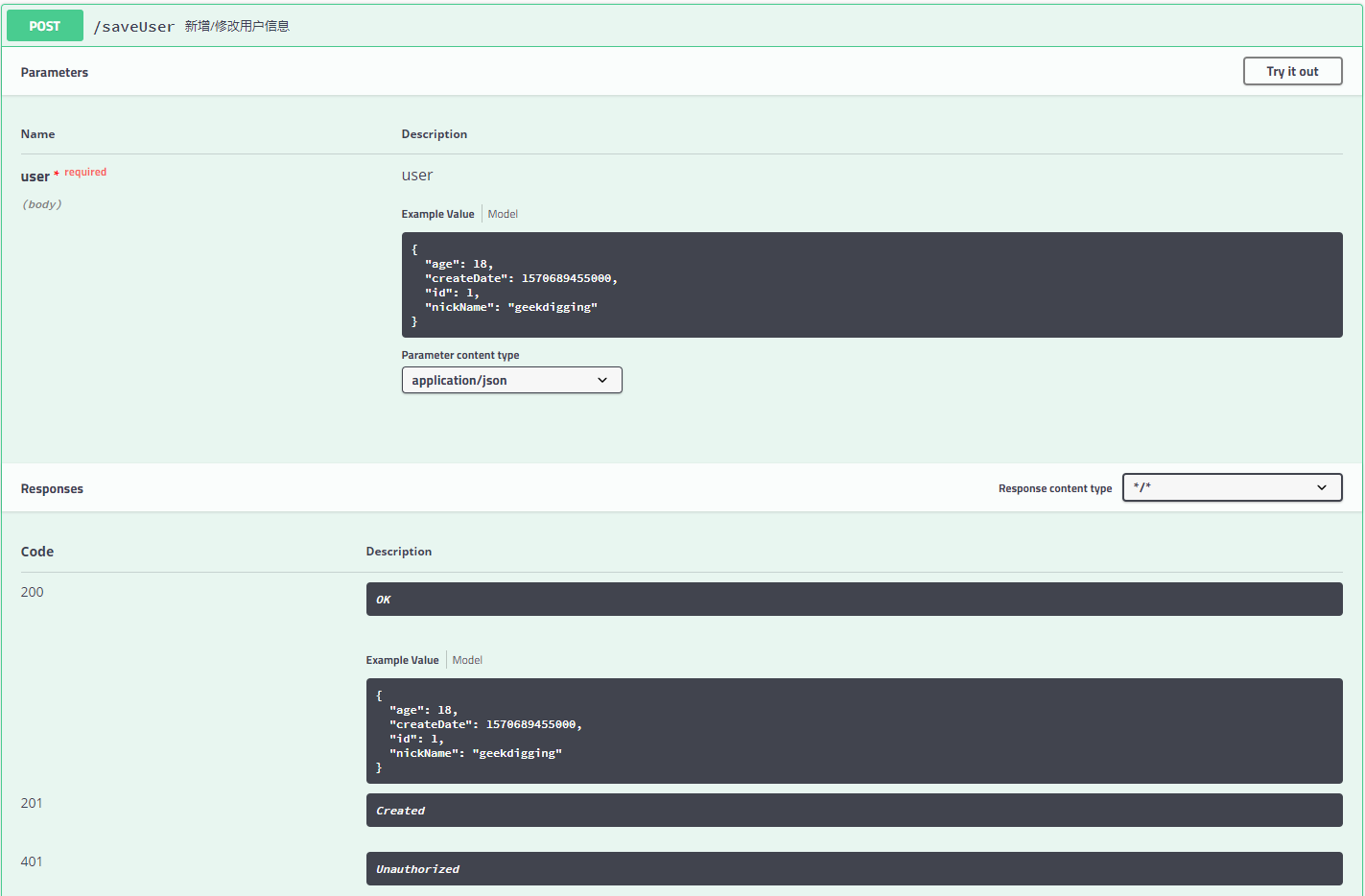
1. 引言
各位在开发的过程中肯定遇到过被接口文档折磨的经历,由于 RESTful 接口的轻量化以及低耦合性,我们在修改接口后文档更新不及时,导致接口的调用方(无论是前端还是后端)经常抱怨接口与文档不一致。程序员的特点是特别不喜欢写文档,但是又同时特别不喜欢别人不写文档。所以 API 文档工具这时就应运而生了,本篇文章我们将会介绍 API 文档工具 Swagger2 。
2. 快速上手
既然 Swagger2 是一个 API 文档工具,我们就在代码中看一下这个文档工具在 Spring Boot 中是如何使用的吧。
2.1 引入依赖
代码清单:spring-boot-swagger/pom.xml***
<!-- swagger工具包 -->
<dependency>
<groupId>io.springfox</groupId>
<artifactId>springfox-swagger2</artifactId>
<version>${swagger.version}</version>
</dependency>
<!-- https://mvnrepository.com/artifact/io.springfox/springfox-swagger-ui -->
<dependency>
<groupId>io.springfox</groupId>
<artifactId>springfox-swagger-ui</artifactId>
<version>${swagger.version}</version>
</dependency>这里选用的版本是 2.9.2 ,同时也是目前最新的一个版本。
2.2 配置类 SwaggerConfig
代码清单:spring-boot-swagger/src/main/java/com/springboot/springbootswagger/config/SwaggerConfig.java***
@Configuration
@EnableSwagger2
public class SwaggerConfig {
@Value("${swagger.show}")
private boolean swaggerShow;
@Bean
public Docket swaggerSpringMvcPlugin() {
return new Docket(DocumentationType.SWAGGER_2)
.enable(swaggerShow)
.apiInfo(apiInfo())
.select()
.apis(RequestHandlerSelectors.basePackage("com.springboot.springbootswagger"))
.paths(PathSelectors.any())
.build();
}
private ApiInfo apiInfo() {
return new ApiInfoBuilder()
.title("Swagger2 演示接口RESTful APIs")
.version("1.0")
.build();
}
}由于 Swagger 是一个 API 文档工具,我们肯定不能在生产环境中开启,所以笔者这里在配置中增加了 swagger.show ,在不同环境的配置文件中配置不同的值,或者如果有配置中心,这个配置可以添加到配置中心中,笔者这里示例简单起见就添加在 application 配置文件中了。这样,我们就可以优雅的开启或者关闭 Swagger 的功能。
2.3 实体类
代码清单:spring-boot-swagger/src/main/java/com/springboot/springbootswagger/model/User.java***
@Data
@AllArgsConstructor
@NoArgsConstructor
@ApiModel(value = "用户演示类", description = "请求参数类")
public class User {
@ApiModelProperty(example = "1", notes = "用户ID")
private Long id;
@ApiModelProperty(example = "geekdigging", notes = "用户名")
private String nickName;
@ApiModelProperty(example = "1570689455000", notes = "创建时间")
private Date createDate;
@ApiModelProperty(example = "18", notes = "用户年龄")
private Integer age;
}Swagger 注解详细说明:
| API | 作用范围 | 使用位置 |
|---|---|---|
| @ApiModel | 描述返回对象的意义 | 用在返回对象类上 |
| @ApiModelProperty | 对象属性 | 用在出入参数对象的字段上 |
| @Api | 协议集描述 | 用于 controller 类上 |
| @ApiOperation | 协议描述 | 用在 controller 的方法上 |
| @ApiResponses | Response集 | 用在 controller 的方法上 |
| @ApiResponse | Response | 用在 @ApiResponses 里边 |
| @ApiImplicitParams | 非对象参数集 | 用在 controller 的方法上 |
| @ApiImplicitParam | 非对象参数描述 | 用在 @ApiImplicitParams 的方法里边 |
2.4 Controller
代码清单:spring-boot-swagger/src/main/java/com/springboot/springbootswagger/controller/UserController.java***
@Api(value = "用户管理演示")
@RestController
public class UserController {
@Autowired
UserService userService;
@GetMapping("/getUserById/{id}")
@ApiOperation(value = "获取用户信息", notes = "根据用户 id 获取用户信息", tags = "查询用户信息类")
public User getUserById(@PathVariable Long id) {
return userService.getUserById(id);
}
@GetMapping("/getAllUsers")
@ApiOperation(value = "获取全部用户信息", notes = "获取全部用户信息", tags = "查询用户信息类")
public List<User> getAllUsers() {
return userService.getAllUsers();
}
@PostMapping("/saveUser")
@ApiOperation(value = "新增/修改用户信息")
public User saveUser(@RequestBody User user) {
return userService.saveUser(user);
}
@DeleteMapping("/deleteById")
@ApiOperation(value = "删除用户信息", notes = "根据用户 id 删除用户信息")
public String deleteById(@PathVariable Long id) {
userService.deleteById(id);
return "success";
}
}- @ApiOperation 中的 tag 标签可用于接口分组
2.5 展示结果如下
启动工程,打开浏览器访问: http://localhost:8080/swagger-ui.html ,可以看到如下页面:

这张图中可以看到我们的 tag 分组。


3. 示例代码
4. 参考
https://blog.csdn.net/xupeng874395012/article/details/68946676
